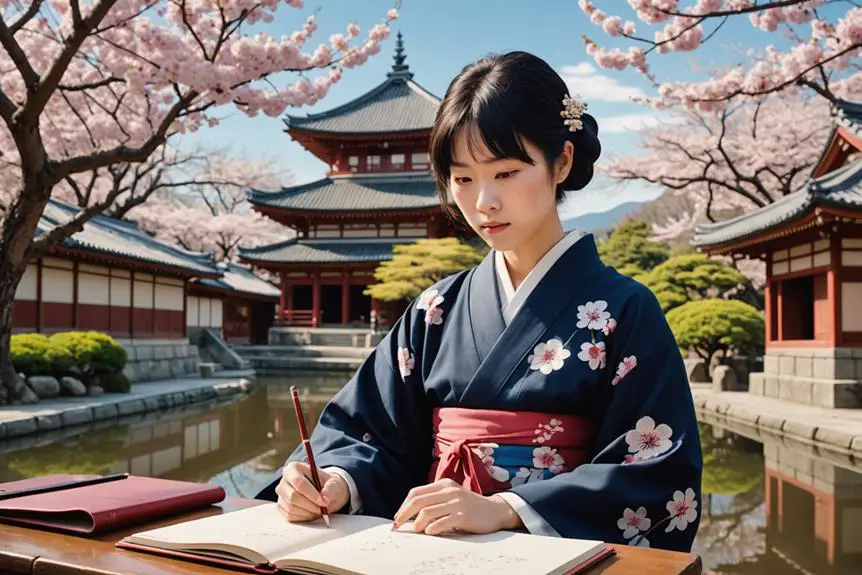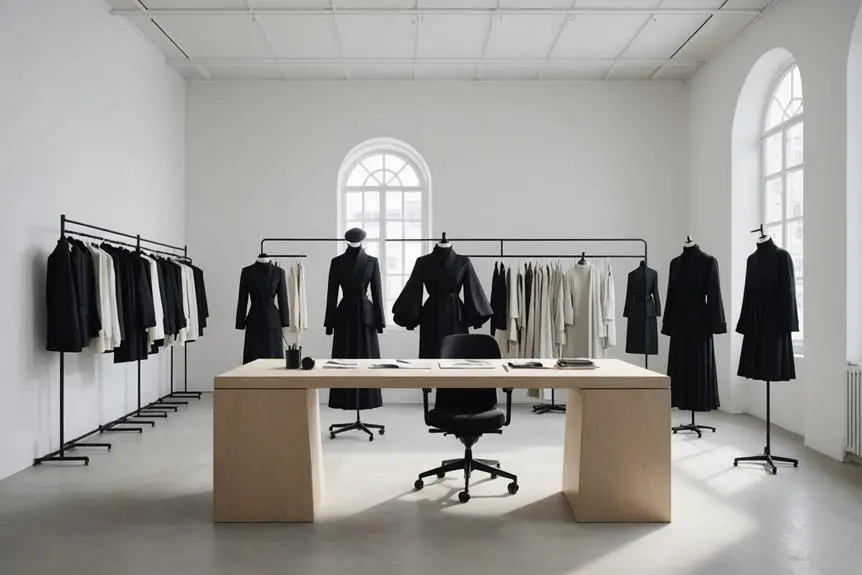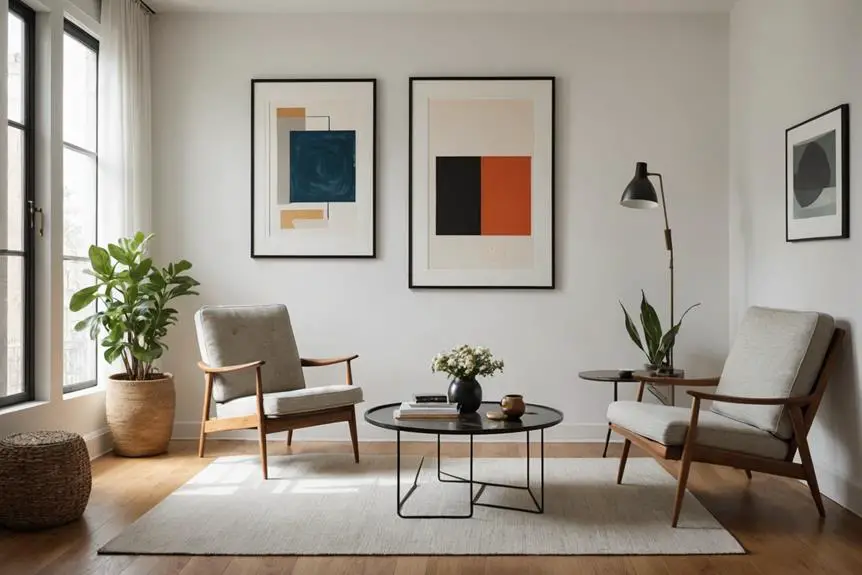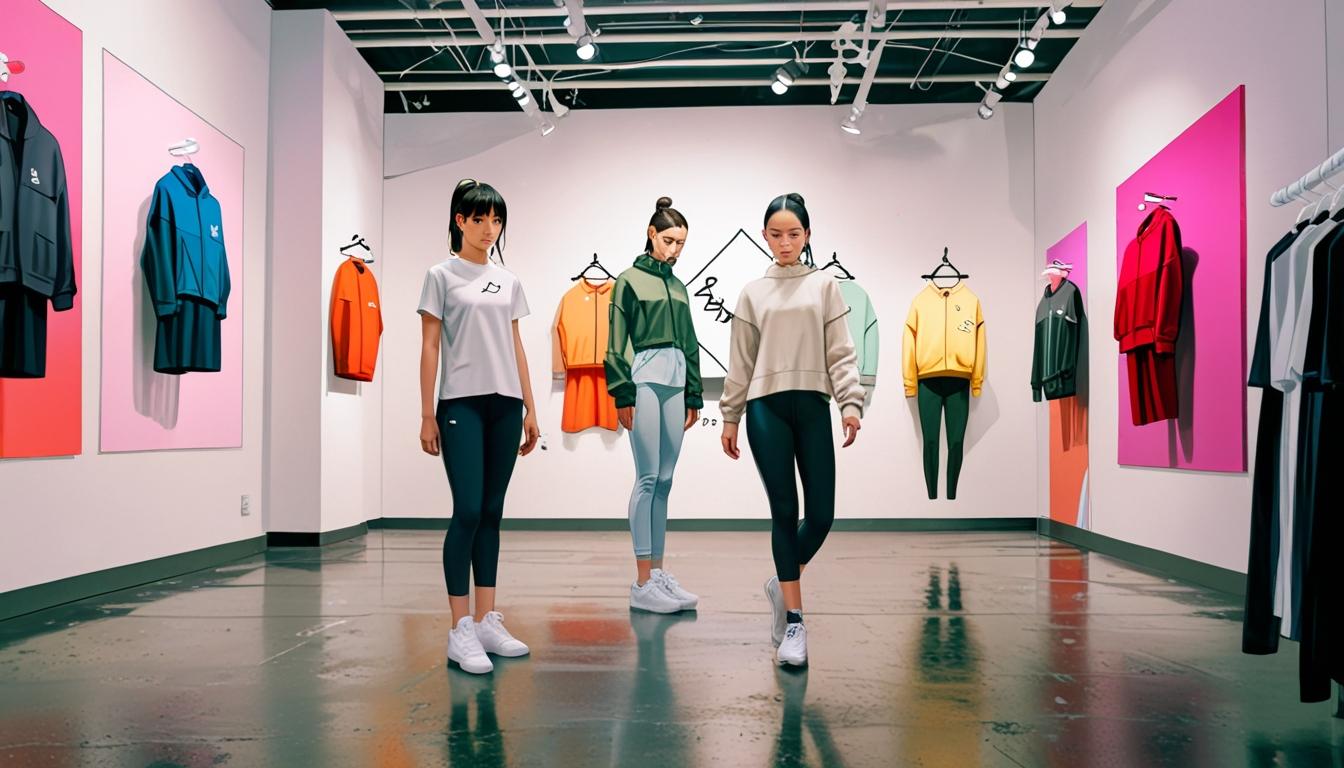When you think about fashion's most influential figures, Rei Kawakubo often comes to mind. Her pivotal role in reshaping the industry with radical designs and a unique approach to beauty is undeniable. From her early days in Tokyo to the prestigious spotlight of the Met, her journey is a compelling narrative filled with both triumphs and challenges. What truly sets her apart is her design philosophy that boldly defies traditional norms. As you reflect on her impact, you'll find yourself questioning how her visionary ideas continue to resonate in today's fashion landscape.
Early Life and Education

Born in Tokyo on October 11, 1942, Rei Kawakubo grew up as the oldest of three children in a family influenced by her mother's progressive attitudes towards traditional gender roles. Her mother's role as an administrator at Keio University and her willingness to defy societal norms ignited a rebellious spirit in Rei, shaping her worldview and later informing her innovative approach to fashion.
Rei pursued her studies in fine arts and literature at Keio University, with a focus on the history of aesthetics. It was during this time that she honed her design philosophy, merging artistic concepts with everyday life. After graduating in 1964, she began her professional journey in advertising at Asahi Kasei, a textile company, before making the bold move to launch her own clothing line, Comme des Garçons, in 1969.
Growing up amidst Japan's postwar recovery and economic boom, Rei witnessed a society undergoing significant transformation. This dynamic backdrop fueled her desire to challenge conventions and embrace creativity. She aimed not just to create clothing, but to make bold statements through her work. Her early life and education laid the groundwork for a career that would go on to redefine the fashion industry. The influence of a strong family presence can have a profound impact, as seen in Rei's remarkable journey.
Career Highlights
Throughout her illustrious career, Rei Kawakubo has consistently pushed the boundaries of fashion, establishing herself as a pioneering force in the industry. She founded Comme des Garçons in 1969, immediately making waves with avant-garde designs that challenged conventional notions of clothing. Her debut in the Paris fashion scene in 1981 with the "Destroy" collection was revolutionary, turning traditional beauty norms on their head and providing a transformative experience for attendees.
By 1978, Kawakubo expanded her vision beyond women's wear, launching menswear under the Comme des Garçons label. Remarkably, by 1980, her brand boasted 150 franchised shops and generated $30 million in revenue—a testament to her business acumen and design innovation. Fast forward to 2017, and she made history as the first living designer to have a solo exhibition at the Metropolitan Museum of Art, featuring around 150 pieces that showcased her remarkable evolution as a designer.
Kawakubo's influence extends through her collaborations with industry giants like H&M, Nike, and Louis Vuitton, where she continually challenges norms and inspires creativity. Her bold choices have reshaped the fashion landscape, ensuring that her legacy endures. When considering the evolution of modern fashion, it's clear that Rei Kawakubo's impact is both profound and admirable.
Design Philosophy

At the core of Rei Kawakubo's design philosophy is a deep-rooted commitment to anti-fashion ideals that challenge conventional perceptions of beauty. This isn't just about following trends; it's about redefining them. Kawakubo's designs frequently embrace asymmetrical shapes and unfinished edges, resulting in a distinctive aesthetic that feels both innovative and powerful. It's as if she begins with a blank canvas, crafting each piece as an audacious statement.
Her iconic collection, "Body Meets Dress, Dress Meets Body," explores the themes of body modification and actively confronts gender stereotypes. Through her work, Kawakubo invites us to reconsider the boundaries of fashion. Her affinity for monochrome palettes, particularly black, serves as a form of resistance—it's a bold choice that defies the common perceptions associated with the color.
Kawakubo's design philosophy is also rooted in collaboration and experimentation. She often communicates with her team through enigmatic prompts, leading to avant-garde creations that provoke thought and evoke emotional reactions. It's clear that each collection transcends mere clothing; it's about sparking dialogue. When you engage with her work, remember that it represents more than just fashion—it's a challenge to societal norms, a playful nudge at conventions, and an invitation to explore your own identity and style. Isn't that exhilarating?
Cultural Impact
Rei Kawakubo's cultural impact reaches far beyond the runway, making a significant mark on the global fashion landscape. As the visionary behind Comme des Garçons, she has been a trailblazer since her groundbreaking 1981 debut collection, "Destroy," which defied conventional beauty standards and established her as a counterculture icon.
Her avant-garde aesthetic not only transformed personal style; it also inspired a new wave of designers, including notable figures like Martin Margiela and Ann Demeulemeester. Kawakubo's work has been instrumental in championing diversity and inclusivity within the fashion industry, particularly advancing LGBT representation in fashion advertising. She has consistently advocated for a space where everyone can find representation in the fashion narrative.
The significance of her contributions was underscored at the 2017 Met Gala, where the exhibition "Art of the In-Between" featured approximately 150 pieces from her extensive oeuvre, making her the first living designer to have a solo exhibition since Yves Saint Laurent in 1983. This was a monumental moment in fashion history.
Rei's accomplishments have been recognized with prestigious accolades, including the CFDA Award for Womenswear Designer of the Year in 1996 and the esteemed Legion of Honor awarded by the French government. Her influence is profound, and she has undoubtedly left an enduring legacy in the realm of fashion. So, whenever you contemplate the evolution of the fashion world, remember Rei Kawakubo—she is a true innovator and game-changer!
Personal Life and Relationships

Kawakubo's personal life presents an intriguing juxtaposition to her audacious public image. Born in Tokyo in 1942, Rei Kawakubo was influenced by her mother, who challenged conventional gender norms, shaping her worldview from an early age. Interestingly, she once had a relationship with fellow designer Yohji Yamamoto, characterized by a dynamic of both rivalry and deep respect.
In 1992, Kawakubo entered into marriage with Adrian Joffe, the CEO of Comme des Garçons. He has been a steadfast supporter, encouraging her through her various fashion endeavors. Despite her significant impact on the fashion industry, Rei places a high value on her privacy, often retreating to a discreet apartment near Aoyama Cemetery, which adds an air of mystery to her persona.
Kawakubo is often perceived as reserved, which can come across as either shy or intimidating. However, those who engage with her in a more personal setting discover a delightful charm and a hidden sense of humor that invites warmth and connection.
Frequently Asked Questions
Who Did Rei Kawakubo Design For?
Kawakubo designs for individuals who embrace avant-garde fashion, drawing inspiration from a variety of cultural influences. Her design philosophy thrives on textile experimentation, runway innovations, and seasonal collections, showcasing her brand's evolution and global impact through notable fashion collaborations.
Who Is the Main Designer of Comme Des Garçons?
The main designer of Comme des Garçons is Rei Kawakubo. Renowned for her avant-garde fashion and distinctive design philosophy, her work is heavily influenced by cultural impact and personal style. Kawakubo drives the brand's evolution through innovative runway presentations and textile experimentation, solidifying her status as a pivotal figure in the fashion industry.
Is Rei Kawakubo a Feminist?
Yes, Rei Kawakubo embodies feminist fashion through her design philosophy. She challenges societal norms, promotes body positivity, and advocates for gender expression, showcasing art influences that empower women's identity politics and cultural impact.
What Does "Comme De Garçon" Mean?
"Comme des Garçons" translates to "like some boys," embodying a fashion philosophy that celebrates avant-garde aesthetics. The evolution of this iconic brand highlights its deep-rooted cultural influences, innovative design methodologies, and striking runway presentations. Its global impact has been significantly bolstered through collaborative projects and groundbreaking textile innovations, solidifying its status as a pillar of contemporary fashion.





Can you be more specific about the content of your article? After reading it, I still have some doubts. Hope you can help me.
Jetton Casino – ??? ?????, ??? ????? ??????????? ? ???????.
? ????? ?????? ??? ???? ??????? ????? ???,
?????? ????? ? ???????????? ???????????.
??????????????? ? ??? ? ??????? ????
??????????? ? ???? ?????? ????? ??????.
?????? ???????? ????????
???? ?????? ???????? ?? ?????? ?????? ? ??????? ?????, ?? ?
???????? ??????? ??? ?????????.
????? ??? ???? ?????????? ???????, ??????, ????????
? ???????????? ???????? ???????????.
????????? ?????? ???????? ??????????? ?? ??????? ???????????.
?????????? ????? ? ???????????? ???????????.
??????????????? ?????? ?????? ? ?????????? ????????.
???????????? ??? ????? ???????? ???????
? ??????? ???????.
???????? ??? ???? ?????? ??????? ??????????? ?????? ? Jetton Casino. https://jetton-casinoempire.makeup/
Paragraph writing is also a excitement, if you know afterward you can write or else it
is difficult to write. https://www.finefishing.ru/files/pgs/ramenbet___chestnoe_onlayn_kazino_s_bustrumi_vuplatami.html
Paragraph writing is also a excitement, if you know afterward you can write or else it is
difficult to write. https://www.finefishing.ru/files/pgs/ramenbet___chestnoe_onlayn_kazino_s_bustrumi_vuplatami.html
I do accept as true with all the concepts you’ve presented for your post.
They’re very convincing and can definitely work. Nonetheless,
the posts are too short for starters. Could you please lengthen them a bit from next time?
Thank you for the post. https://ruptur.com/libs/photo/igray_v_ramenbet__licenziya__slotu__bonusu_24_7.html
I do accept as true with all the concepts you’ve presented
for your post. They’re very convincing and can definitely work.
Nonetheless, the posts are too short for starters. Could you please lengthen them a bit from next time?
Thank you for the post. https://ruptur.com/libs/photo/igray_v_ramenbet__licenziya__slotu__bonusu_24_7.html
Jetton Casino – ??? ?????, ??? ????? ??????????? ? ???????.
? ????? ?????? ??? ???? ??????? ????? ???, ?????? ????? ? ???????????? ???????????.
??????????????? ? ????????? ?????? ??? ????????? ??????.
??? ?????? ?????? ?????? ??? ???? ??????????
?? ?????????? ??????? ????, ???????????? ???????
? ?????????????? ?????????. ?????? ???????????? ????? ???????????? ?? ??????????? ????? ? ???????????? ???????.
???????? ????? ??????? ?????????, ???????, ?????? ? ????-???.
?????????? ????? ? ???????????? ???????????.
??????? ??????? ? ?????????? ??????????
??? ????????.
??????? ? ???????? ????????? ??????? ? ??????????? ???????? ???????.
Jetton Casino – ??? ??? ???? ? ???? ?????? ?
??????? ?????????. https://jettoncasino-exclusive.top/
Jetton Casino – ??? ?????, ??? ????? ??????????? ? ???????.
? ????? ?????? ??? ???? ??????? ????? ???, ?????? ????? ? ???????????? ???????????.
??????????????? ? ????????? ?????? ??? ?????????
??????.
??? ?????? ?????? ?????? ??? ???? ??????????
?? ?????????? ??????? ????, ???????????? ??????? ?
?????????????? ?????????.
?????? ???????????? ????? ???????????? ?? ???????????
????? ? ???????????? ???????.
???????? ????? ??????? ?????????,
???????, ?????? ? ????-???.
?????????? ????? ? ???????????? ???????????.
??????? ??????? ? ?????????? ?????????? ??? ????????.
??????? ? ???????? ????????? ??????? ? ??????????? ???????? ???????.
Jetton Casino – ??? ??? ???? ? ???? ?????? ? ??????? ?????????. https://jettoncasino-exclusive.top/
[url=https://carburater.com/]????? ??? ??? ???? ???? [/url]is a useful free tool that helps buyers understand the background of any car before making a decision, and it becomes even more important when exploring a global marketplace of classic cars for sale. All around the world, collectors and enthusiasts search for antique automobiles with historical value, and having accurate data at the beginning of the process helps define whether a vehicle has true potential. With online platforms bringing together classic car dealers from multiple countries, buyers can now access hundreds of classic cars listed by make, year and condition, making the search for the perfect classic easier than ever. A simple number check helps reveal ownership history, maintenance records and restoration notes, ensuring buyers know exactly what they are looking at. The world of classic cars offers iconic American muscle cars, elegant European antiques and rare Japanese oldtimers, and browsing these selections becomes more efficient when supported by accurate information. Whether someone is planning to buy, rent or simply explore available listings, global classic car marketplaces provide professional dealer profiles that make communication and negotiation smoother. Enthusiasts often appreciate the ability to view cars by manufacturer, including legendary brands that shaped automotive history, helping them narrow down their preferences. At the same time, browsing by location allows potential buyers to find vehicles in regions known for well-maintained and carefully restored vintage cars. With the growth of online classic car platforms, more sellers are showcasing their restored vehicles to a global audience, offering buyers transparent documentation that includes before-and-after photos. This level of detail helps collectors understand the vehicle’s authenticity and long-term value. A free number check becomes an essential part of this evaluation, serving as an easy method to verify information before making contact with a dealer. In a marketplace where every classic car has its own story, having accurate facts allows enthusiasts to choose models that match their expectations. Today, with hundreds of classic cars available online in one place, the combination of global dealer listings, vehicle history verification and detailed restoration data gives buyers a complete view of the classic automotive world, helping them make informed decisions and discover vehicles that truly stand out.
https://carburater.com/